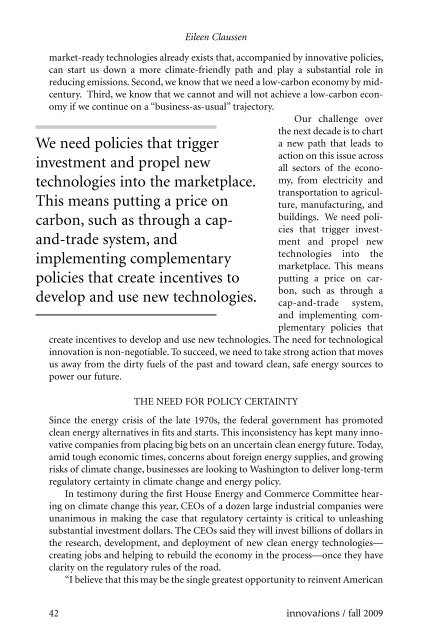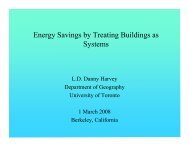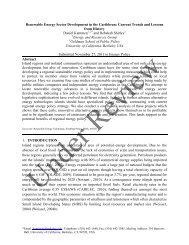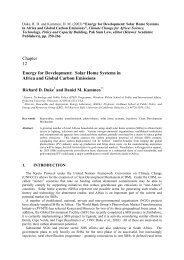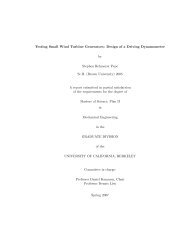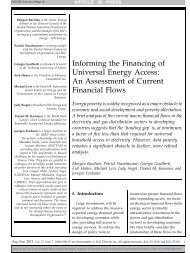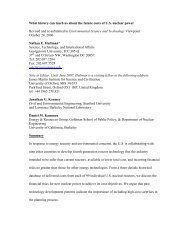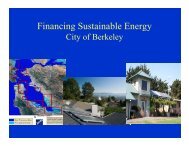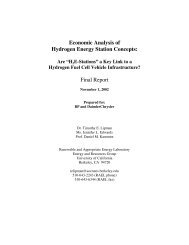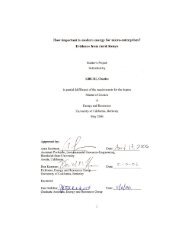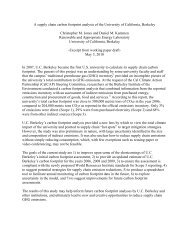Innovations, Energy for Change, Fall 2009.pdf - Renewable and ...
Innovations, Energy for Change, Fall 2009.pdf - Renewable and ...
Innovations, Energy for Change, Fall 2009.pdf - Renewable and ...
You also want an ePaper? Increase the reach of your titles
YUMPU automatically turns print PDFs into web optimized ePapers that Google loves.
Eileen Claussen<br />
market-ready technologies already exists that, accompanied by innovative policies,<br />
can start us down a more climate-friendly path <strong>and</strong> play a substantial role in<br />
reducing emissions. Second, we know that we need a low-carbon economy by midcentury.<br />
Third, we know that we cannot <strong>and</strong> will not achieve a low-carbon economy<br />
if we continue on a “business-as-usual” trajectory.<br />
Our challenge over<br />
the next decade is to chart<br />
We need policies that trigger<br />
investment <strong>and</strong> propel new<br />
technologies into the marketplace.<br />
This means putting a price on<br />
carbon, such as through a cap<strong>and</strong>-trade<br />
system, <strong>and</strong><br />
implementing complementary<br />
policies that create incentives to<br />
develop <strong>and</strong> use new technologies.<br />
a new path that leads to<br />
action on this issue across<br />
all sectors of the economy,<br />
from electricity <strong>and</strong><br />
transportation to agriculture,<br />
manufacturing, <strong>and</strong><br />
buildings. We need policies<br />
that trigger investment<br />
<strong>and</strong> propel new<br />
technologies into the<br />
marketplace. This means<br />
putting a price on carbon,<br />
such as through a<br />
cap-<strong>and</strong>-trade system,<br />
<strong>and</strong> implementing complementary<br />
policies that<br />
create incentives to develop <strong>and</strong> use new technologies. The need <strong>for</strong> technological<br />
innovation is non-negotiable. To succeed, we need to take strong action that moves<br />
us away from the dirty fuels of the past <strong>and</strong> toward clean, safe energy sources to<br />
power our future.<br />
THE NEED FOR POLICY CERTAINTY<br />
Since the energy crisis of the late 1970s, the federal government has promoted<br />
clean energy alternatives in fits <strong>and</strong> starts. This inconsistency has kept many innovative<br />
companies from placing big bets on an uncertain clean energy future. Today,<br />
amid tough economic times, concerns about <strong>for</strong>eign energy supplies, <strong>and</strong> growing<br />
risks of climate change, businesses are looking to Washington to deliver long-term<br />
regulatory certainty in climate change <strong>and</strong> energy policy.<br />
In testimony during the first House <strong>Energy</strong> <strong>and</strong> Commerce Committee hearing<br />
on climate change this year, CEOs of a dozen large industrial companies were<br />
unanimous in making the case that regulatory certainty is critical to unleashing<br />
substantial investment dollars. The CEOs said they will invest billions of dollars in<br />
the research, development, <strong>and</strong> deployment of new clean energy technologies—<br />
creating jobs <strong>and</strong> helping to rebuild the economy in the process—once they have<br />
clarity on the regulatory rules of the road.<br />
“I believe that this may be the single greatest opportunity to reinvent American<br />
42 innovations / fall 2009


